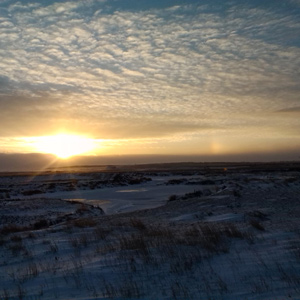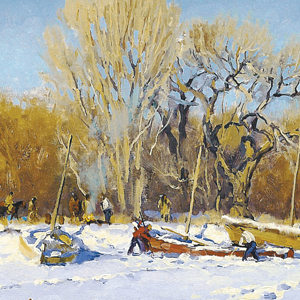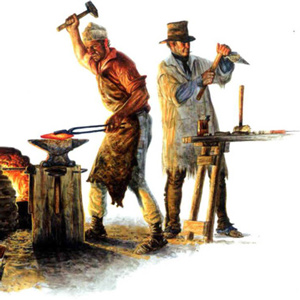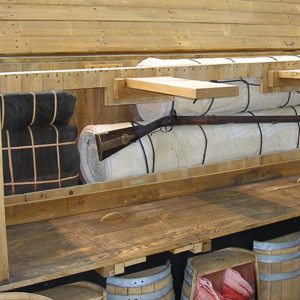The fourth literate explorer to go up the Yellowstone was François-Antoine Larocque. The fifth was William Clark. Larocque is important to the story of Lewis and Clark on the Middle Missouri for several reasons.
Related Pages
Larocque at Fort Mandan
by Joseph A. Mussulman

In the fall of 1804, Larocque’s job was to take a supply of North West Company merchandise to the Mandan and Hidatsa villages and trade for furs. While there, he asked the captains if he could join the expedition.
Larocque’s Yellowstone Journey
One year before Clark


The fourth literate explorer to go up the Yellowstone (and before Clark) was François-Antoine Larocque, who is important to the story of Lewis and Clark on the Middle Missouri for several reasons.


Manuel Lisa’s men at Fort Raymond not only encouraged the Crows to come trade with them, but they set out parties to trap beaver on their own. It was the latter effort that led to hostilities with the Blackfeet that affected Potts, Drouillard, and Colter.
November 8, 1804
Riving cottonwood logs


Sgt. Ordway is hopeful that their cottonwood logs will rive well—split into boards. He reports that they will have to give up on that plan. Traders from Canada arrive at the Hidatsa villages.
November 27, 1804
Mandan deceptions


Lewis returns to Fort Mandan with two Hidatsa chiefs, and the captains learn that the Mandans have been telling lies to the Hidatsas. Seven Canada-based traders arrive at the Knife River Villages.
November 29, 1804
Pryor's trick shoulder


At Fort Mandan below the Knife River Villages, the river falls leaving the barge on dry land. In removing its rigging, Sgt. Pryor dislocates his shoulder, and four attempts must be made to place it.
December 13, 1804
Corn and beans


At Fort Mandan, Sgt. Ordway sends two men to Mitutanka to trade for corn and beans. Pvt. Joseph Field kills two buffalo, and a trader from the North West Company comes to collect one of Charbonneau’s horses.
December 16, 1804
A letter from Chaboillez


At Fort Mandan, traders Hugh Heney and François-Antoine Larocque bring a letter from the manager of Fort Assiniboine of the North West Company accompanied by George Budge of the Hudson’s Bay Company.
December 26, 1804
The good old game


A North West Company trader comes to Fort Mandan to hire Charbonneau as a translator. Clark learns that a Hidatsa attempt to retrieve stolen horses was somewhat successful, and Lewis plays backgammon.
January 3, 1805
A safe refuge


A Hidatsa man comes for his wife who is seeking refuge at Fort Mandan, and hunters return with a white-tailed jackrabbit. Charbonneau and one enlisted man arrive late at one of the Hidatsa villages.
January 11, 1805
War medicine dance


Posecopsahe (Black Cat) of Ruptáre and The Coal of Mitutanka visit Fort Mandan and spend the night. At Mitutanka village, several soldiers witness a war medicine dance—perhaps the Mandan Wolf Ceremony.
January 18, 1805
The "Brarow" (badger)


At Fort Mandan, two traders staying at a nearby Hidatsa village visit the captains. Hunters bring in four wolf skins and a badger, the latter identified by the visitors as a “brarow”—a badger.
January 19, 1805
Fort Mandan departures


At Fort Mandan below the Knife River Villages, one of the interpreter’s wives leaves after a jealous spat. Two North West Company traders leave, and Clark offers to care for and protect their horses.
January 22, 1805
Boats gripped in ice


At Fort Mandan below the Knife River Villages, an unsuccessful attempt is made to cut the Missouri River ice from around the boats. They find two layers of ice nearly four feet thick.
January 30, 1805
Mr. Larocque's rejection


François-Antoine Larocque comes to Fort Mandan to have his compass fixed and to check on his horses that are being kept safe from visiting Assiniboines. The captains deny his request to join the expedition.
February 2, 1805
Mr. Larocque's compass


At Fort Mandan, Lewis fixes North West Company trader François-Antoine Larocque’s compass, but latter’s attempt to join the expedition fails. One of the interpreters’ wives—perhaps Sacagawea—is taken ill.
March 13, 1805
Busy blacksmiths


At Fort Mandan below the Knife River Villages, the Mandans and Hidatsas are anxious for the blacksmiths to make war axes before the expedition leaves for the Western Sea. North West Company traders visit.
March 22, 1805
Man Wolf Chief visits


At Fort Mandan, Man Wolf Chief of Menetarra is given the standard diplomatic treatment: an Indian peace medal, gifts, and a speech. Engagé François Rivet comes for his canoe.
March 23, 1805
A Hidatsa vocabulary


Fur trade clerks Charles McKenzie and François-Antoine Larocque end their visit at Fort Mandan in present North Dakota. A Hidatsa man helps the captains record a vocabulary of his language.
April 4, 1805
McKenzie's recollections


At Fort Mandan, the barge is loaded and made ready for its return to St. Louis. Interactions with Canadian traders François-Antoine Larocque and Charles McKenzie are recalled by McKenzie several years later.


Via the shorter route, Pryor would have arrived at the Knife River villages by about 6 August 1806. A trip to see Hugh Heney at Fort Assiniboine would take another two weeks.
Experience the Lewis and Clark Trail
The Lewis and Clark Trail Experience—our sister site at lewisandclark.travel—connects the world to people and places on the Lewis and Clark Trail.
Discover More
- The Lewis and Clark Expedition: Day by Day by Gary E. Moulton (University of Nebraska Press, 2018). The story in prose, 14 May 1804–23 September 1806.
- The Lewis and Clark Journals: An American Epic of Discovery (abridged) by Gary E. Moulton (University of Nebraska Press, 2003). Selected journal excerpts, 14 May 1804–23 September 1806.
- The Lewis and Clark Journals. by Gary E. Moulton (University of Nebraska Press, 1983–2001). The complete story in 13 volumes.

